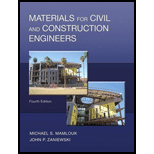
Concept explainers
Coarse aggregate is placed in a rigid bucket and rodded with a tamping rod to determine its unit weight. The following data are obtained:
Volume of bucket =
Weight of empty bucket = 20.3 lb
Weight of bucket filled with dry rodded coarse aggregate:
Trial 1 = 76.6 lb
Trial 2 = 75.1 lb
Trial 3 = 78.8 lb
a. Calculate the average dry-rodded unit weight
b. If the bulk dry specific gravity of the aggregate is 2.620, calculate the percent voids between aggregate particles for each trial
Want to see the full answer?
Check out a sample textbook solution
Chapter 5 Solutions
Materials for Civil and Construction Engineers (4th Edition)
Additional Engineering Textbook Solutions
Management Information Systems: Managing The Digital Firm (16th Edition)
Mechanics of Materials (10th Edition)
Database Concepts (8th Edition)
Electric Circuits. (11th Edition)
SURVEY OF OPERATING SYSTEMS
Concepts Of Programming Languages
- Note: Please provide a clear, step-by-step, simplified handwritten working out (no explanations!), ensuring it is completed without any AI involvement. I require an expert-level answer and will assess and rate your work based on its quality and accuracy, refer to the provided image for additional clarity. Make sure to double-check everything for correctness before submitting. Thanks, appreciate your time and effort!.arrow_forwardNeed help!! Add martin luther king jr day as a holiday so it won't be a work dayarrow_forwardضهقعفكضكشتبتلتيزذظظؤوروىووؤءظكصحبت٢٨٩٤٨٤ع٣خ٩@@@#&#)@)arrow_forward
- A steel rod 100 ft long holds a 200 lb weight as shown. If the diameter of the circular rod is ¼ inch, find the maximum normal stress in the road, taking into account the weight of the rod itself. Use: density of steel = ϒ = 490 lb/ft3 .arrow_forwardضهقعفكضكشتبتلتيزذظظؤوروىووؤءظكصحبت٢٨٩٤٨٤ع٣خ٩@@@#&#)@)arrow_forwardضهقعفكضكشتبتلتيزذظظؤوروىووؤءظكصحبت٢٨٩٤٨٤ع٣خ٩@@@#&#)@)arrow_forward
- A square flexible foundation of width B applies a uniform pressure go to the underlying ground. (a) Determine the vertical stress increase at a depth of 0.5B below the center using Aσ beneath the corner of a uniform rectangular load given by Aσ Variation of Influence Value I m n 0.5 0.6 0.8 1.0 0.2 0.4 0.2 0.01790 0.03280 0.03866 0.04348 0.05042 0.05471 0.4 0.03280 0.06024 0.07111 0.08009 0.09314 0.10129 0.5 0.03866 0.07111 0.08403 0.09473 0.11035 0.12018 0.6 0.04348 0.08009 0.09473 0.10688 0.12474 0.13605 0.8 0.05042 0.09314 0.11035 0.12474 0.14607 0.15978 1.0 0.05471 0.10129 0.12018 0.13605 0.15978 0.17522 (Enter your answer to three significant figures.) Ασ/90 = Activity Frame (b) Determine the vertical stress increase at a depth of 0.5B below the center using the 2 : 1 method equation below. 90 x B x L Aσ = (B+ z) (L+ z) (Enter your answer to three significant figures.) Δσ/90 = (c) Determine the vertical stress increase at a depth of 0.5B below the center using stress isobars in…arrow_forwardNeed help!!!arrow_forward2 A flexible circular area is subjected to a uniformly distributed load of 450 kN/m² (the figure below). The diameter of the load area is 2 m. Estimate the average stress increase (Aσay) below the center of the loaded area between depths of 3 m and 6 m. H₂ 1.0 H₂ B 0.8 CHI HD DV 0.6 C 1.0 1.5 0.4 0.2 6.0 8.0. 10.0 2.0 2.5 3.0 4.0 5.0 H₁ (Enter your answer to two significant figures.) Δσαν τ kN/m² 6arrow_forward
- Refer to the figure below. Using the procedure outlined in your textbook, determine the average stress increase in the clay layer below the center of the foundation due to the net foundation load of 45 tons. Use the equations: Aσ = and qo x B x L (B+ z)(L+ z) Aσ av (H2/H₁) Δσι +44 + Δσο net load 6 4:5 ft 10 ft 5ft x 5ft Sand Sand y=100 lb/ft³ Ysat 122 lb/ft³:" Ysat 120 lb/ft³: 0.7 C=0.25 Groundwater table C=0.06 Preconsolidation pressure = 2000 lb/ft² (Enter your answer to three significant figures.) Ασαν = lb/ft²arrow_forwardRefer to the figure below, which shows a flexible rectangular area. Given: B₁ = 4 ft, B₂ = 6 ft, L₁ = 8 ft, and L2 = 10 ft. If the area is subjected to a uniform load of 4100 lb/ft², determine the stress increase at a depth of 10 ft located immediately below point O. Use the table below. T B(1) 3 B(2) 2 L(1) * 4 L2) Table 1 Variation of Influence Value I n m 0.8 0.9 1.0 1.2 1.4 0.1 0.02576 0.02698 0.02794 0.02926 0.03007 0.2 0.05042 0.05283 0.05471 0.05733 0.05894 0.3 0.07308 0.07661 0.07938 0.08323 0.08561 0.4 0.09314 0.09770 0.10129 0.10631 0.10941 0.5 0.11035 0.11584 0.12018 0.12626 0.13003 0.6 0.12474 0.13105 0.13605 0.14309 0.14749 0.7 0.13653 0.14356 0.14914 0.15703 0.16199 0.8 0.14607 0.15371 0.15978 0.16843 0.17389 0.9 0.15371 0.16185 0.16835 0.1766 0.18357 1.0 0.15978 0.16835 0.17522 0.18508 0.19139 1.1 0.16843 0.17766 0.18508 0.19584 0.20278 (Enter your answer to three significant figures.) Aσ = lb/ft²arrow_forwardPoint loads of magnitude 100, 200, and 380 kN act at B, C, and D, respectively (in the figure below). Determine the increase in vertical stress at a depth of 6 m below point A. Use Boussinesq's equation. B 6 m A 6 m с 3 m D (Enter your answer to three significant figures.) Δαχτ kN/m²arrow_forward
 Fundamentals of Geotechnical Engineering (MindTap...Civil EngineeringISBN:9781305635180Author:Braja M. Das, Nagaratnam SivakuganPublisher:Cengage Learning
Fundamentals of Geotechnical Engineering (MindTap...Civil EngineeringISBN:9781305635180Author:Braja M. Das, Nagaratnam SivakuganPublisher:Cengage Learning Steel Design (Activate Learning with these NEW ti...Civil EngineeringISBN:9781337094740Author:Segui, William T.Publisher:Cengage Learning
Steel Design (Activate Learning with these NEW ti...Civil EngineeringISBN:9781337094740Author:Segui, William T.Publisher:Cengage Learning Principles of Geotechnical Engineering (MindTap C...Civil EngineeringISBN:9781305970939Author:Braja M. Das, Khaled SobhanPublisher:Cengage Learning
Principles of Geotechnical Engineering (MindTap C...Civil EngineeringISBN:9781305970939Author:Braja M. Das, Khaled SobhanPublisher:Cengage Learning Traffic and Highway EngineeringCivil EngineeringISBN:9781305156241Author:Garber, Nicholas J.Publisher:Cengage Learning
Traffic and Highway EngineeringCivil EngineeringISBN:9781305156241Author:Garber, Nicholas J.Publisher:Cengage Learning Solid Waste EngineeringCivil EngineeringISBN:9781305635203Author:Worrell, William A.Publisher:Cengage Learning,
Solid Waste EngineeringCivil EngineeringISBN:9781305635203Author:Worrell, William A.Publisher:Cengage Learning, Materials Science And Engineering PropertiesCivil EngineeringISBN:9781111988609Author:Charles GilmorePublisher:Cengage Learning
Materials Science And Engineering PropertiesCivil EngineeringISBN:9781111988609Author:Charles GilmorePublisher:Cengage Learning





